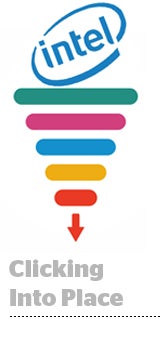Intel has a product to sell, but it’s not a retailer. And that’s where campaign management gets tricky.
The chip manufacturer has long partnered with retailers and ecommerce sites like Walmart, Best Buy, Target and Amazon to sell laptops and desktop computers with Intel processors inside.
Intel, which doesn’t sell consumer-facing hardware on its own site, earmarks media dollars to push consumers to these other properties. The arrangement is mutually beneficial, but there’s one thing that’s a little frustrating for Intel.
Retailers generally won’t allow Intel to put its own conversion pixel or third-party tags on their websites, said Jon Eenigenburg, an audience strategist who sits on the team within Intel responsible for data enablement and campaign measurement.
But although that reticence is “understandable,” he said – what walled garden likes sharing data? – it leaves Intel with incomplete insight into campaign performance.
Intel gets reporting back from online retail partners on aggregated sales data for the SKUs being promoted, as well as info on whether someone who clicked through an ad ended up completing a purchase within that same session.
But Intel still has a few measurement “blind spots within some walled gardens,” Eenigenburg said, including a view into consumer behavior across Intel’s full network of retail marketplace partners.
To try and get a better picture of the entire marketing funnel, Intel is working with Jumpshot, a marketing analytics company akin to SimilarWeb that uses a global panel of 100 million devices to track online behavior across every URL a user visits before converting or taking some other designated action.
Intel first tested the solution for a holiday campaign promoting Intel-powered laptops which served more than 1 billion impressions targeted primarily at an audience of “trendy,” tech-savvy moms. Intel integrated Jumpshot’s tracking pixel into its digital display assets to measure browsing and shopping behavior before and after exposure to Intel ads compared to an unexposed control group.
By comparing the two audiences, Intel was able to measure campaign-related performance and ROI. Intel proved a 22% increase in product views and a 24% uptick in conversions across ecommerce domains. There was also a 32% spike in visits to intel.com.
At the top of the funnel, Intel uses surveys and post-campaign interviews to determine ad recall and purchase intent. Jumpshot comes in at the bottom to help assess what’s happening closer to the sale.
“We have qualitative research in place, but we have to measure the actual behaviors,” Eenigenburg said. “[There are] different tactics at play across the funnel.”
But most marketers are unable to connect behavior to all of the different places where consumers can buy products online, said Deren Baker, CEO of Jumpshot. Eighty-four percent say they’re challenged by a lack of insights into purchase behavior across ecommerce marketplaces, according to a survey of 300 marketers conducted by Jumpshot in June.
“If you’re a brand and you launch a digital marketing campaign, you’ve got limited visibility into the downstream performance and you can’t attribute your marketing dollars to the conversions happening on third-party ecommerce sites,” Baker said. “Brands know they need to sell in these marketplaces – that’s where consumers go to buy their products – but it’s just hard to trust the data and it’s hard to connect the dots.”















